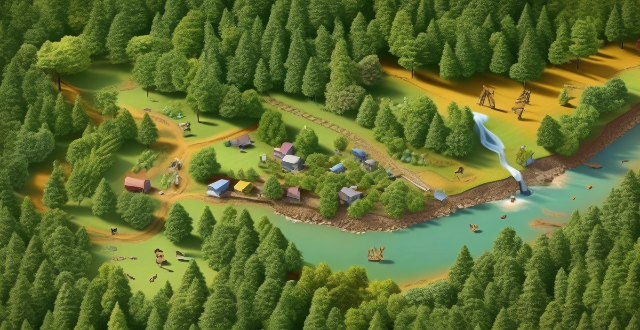This article discusses the impacts of changes in temperature and precipitation patterns on different ecosystems, including forests, grasslands, wetlands, and arctic tundra. It highlights how these changes can affect plant growth and productivity, species composition, water availability, nutrient cycling, soil erosion, and other ecosystem processes. The article also emphasizes the importance of understanding these impacts to inform conservation and management strategies for ecosystems in a changing climate.

Response of Different Ecosystems to Changes in Temperature and Precipitation Patterns
Ecosystems are complex communities of living and non-living components that interact with each other. They are sensitive to changes in environmental conditions, including temperature and precipitation patterns. The response of ecosystems to these changes can vary depending on the type of ecosystem, its location, and the magnitude and frequency of the changes. In this discussion, we will explore how different ecosystems respond to changes in temperature and precipitation patterns.
Forest Ecosystems
Forest ecosystems are diverse and complex, and they play a crucial role in maintaining biodiversity and providing ecosystem services such as carbon sequestration, water regulation, and soil conservation. Changes in temperature and precipitation patterns can have significant impacts on forest ecosystems.
Impacts of Temperature Changes
- Tree Growth and Mortality: Warmer temperatures can lead to increased tree growth rates, but extreme heat events can cause tree mortality due to drought stress and heat-related injuries.
- Phenology: Changes in temperature can affect the timing of plant developmental stages, such as flowering and leaf-out, which can impact pollination and seed production.
- Insect Pests and Diseases: Warmer temperatures can increase the range and abundance of insect pests and diseases, leading to increased damage to trees.
Impacts of Precipitation Changes
- Water Availability: Changes in precipitation patterns can affect water availability for plants, leading to drought stress or flooding.
- Nutrient Cycling: Changes in precipitation can affect nutrient cycling processes, such as decomposition and mineralization, which can impact plant growth and productivity.
- Soil Erosion: Increased precipitation can lead to soil erosion, especially in areas with steep slopes or poor soil structure.
Grassland Ecosystems
Grasslands are dominated by grasses and other herbaceous plants and are characterized by low aboveground biomass and high belowground biomass. They are important for livestock grazing, wildlife habitat, and soil conservation. Changes in temperature and precipitation patterns can have significant impacts on grassland ecosystems.
Impacts of Temperature Changes
- Plant Growth and Productivity: Warmer temperatures can lead to increased plant growth rates, but extreme heat events can cause drought stress and reduced productivity.
- Species Composition: Changes in temperature can alter the competitive interactions among plant species, leading to shifts in species composition and diversity.
- Fire Regimes: Warmer temperatures can increase the risk of wildfires, which can have significant impacts on grassland structure and function.
Impacts of Precipitation Changes
- Water Availability: Changes in precipitation patterns can affect water availability for plants, leading to drought stress or flooding.
- Soil Moisture: Changes in precipitation can affect soil moisture levels, which can impact plant growth and productivity.
- Nutrient Cycling: Changes in precipitation can affect nutrient cycling processes, such as decomposition and mineralization, which can impact plant growth and productivity.
Wetland Ecosystems
Wetlands are areas where water covers the soil or is present at or near the surface of the soil all year or during part of the year. They provide important ecosystem services such as flood control, water purification, and wildlife habitat. Changes in temperature and precipitation patterns can have significant impacts on wetland ecosystems.
Impacts of Temperature Changes
- Water Levels: Warmer temperatures can lead to increased evapotranspiration rates, which can lower water levels in wetlands.
- Plant Growth and Productivity: Changes in temperature can affect plant growth rates and productivity, as well as the distribution of plant species within the wetland.
- Animal Habitat: Changes in temperature can affect the distribution and abundance of animal species within the wetland, as well as their behavior and reproductive success.
Impacts of Precipitation Changes
- Water Levels: Changes in precipitation patterns can affect water levels in wetlands, leading to drought stress or flooding.
- Salinity: Changes in precipitation can affect salinity levels in coastal wetlands, which can impact plant and animal communities.
- Sedimentation: Increased precipitation can lead to increased sedimentation rates in wetlands, which can impact water quality and plant growth.
Arctic Tundra Ecosystems
Arctic tundra ecosystems are characterized by cold temperatures, short growing seasons, and permafrost. They are important for carbon storage, wildlife habitat, and cultural values. Changes in temperature and precipitation patterns can have significant impacts on arctic tundra ecosystems.
Impacts of Temperature Changes
- Permafrost Thawing: Warmer temperatures can lead to thawing of permafrost, which can result in changes in landscape structure and ecosystem function.
- Carbon Release: Thawing permafrost can release large amounts of stored carbon into the atmosphere, exacerbating climate change.
- Plant Growth and Productivity: Changes in temperature can affect plant growth rates and productivity, as well as the distribution of plant species within the tundra.
Impacts of Precipitation Changes
- Water Availability: Changes in precipitation patterns can affect water availability for plants, leading to drought stress or flooding.
- Soil Erosion: Increased precipitation can lead to soil erosion, especially in areas with poor soil structure or vegetation cover.
- Nutrient Cycling: Changes in precipitation can affect nutrient cycling processes, such as decomposition and mineralization, which can impact plant growth and productivity.